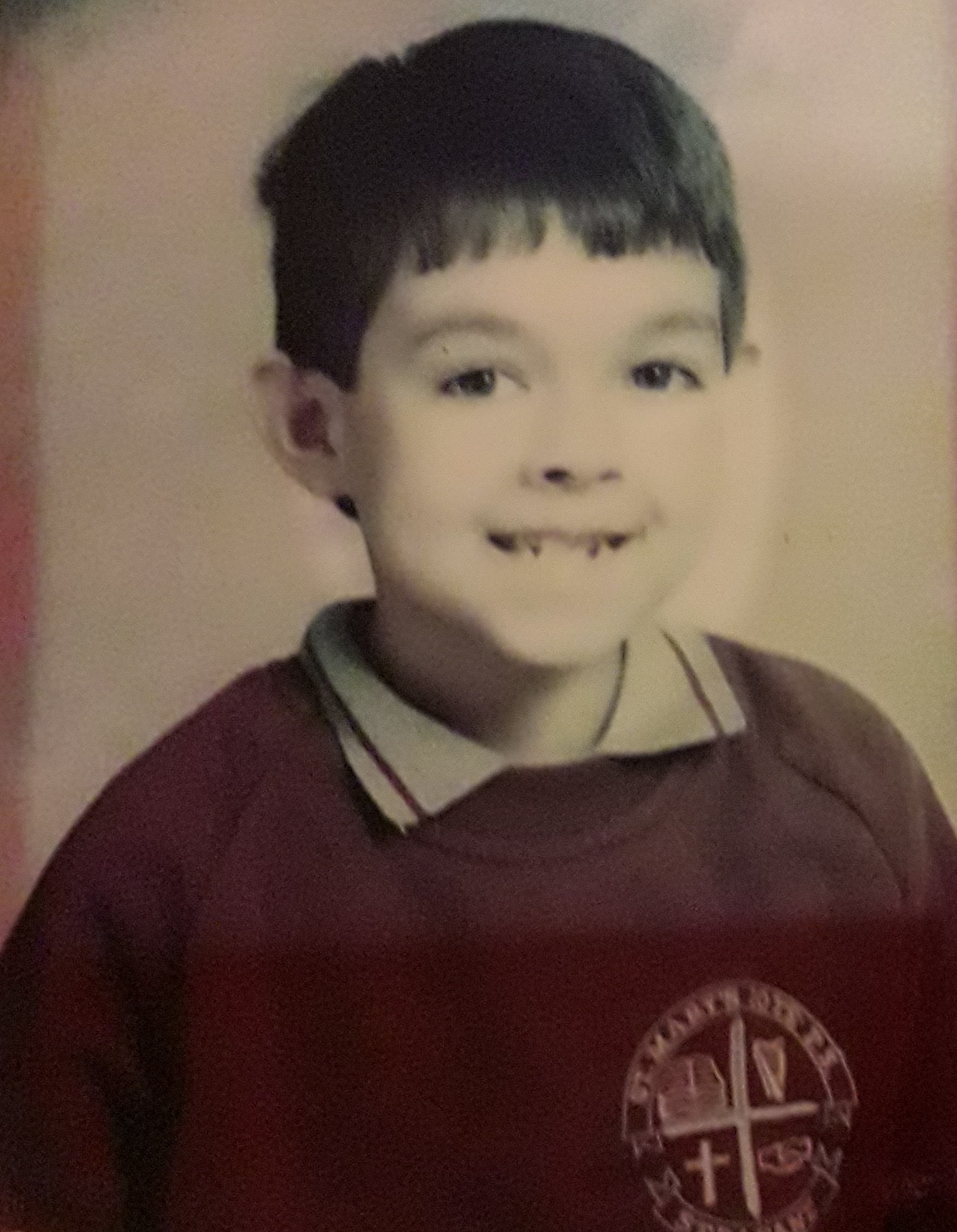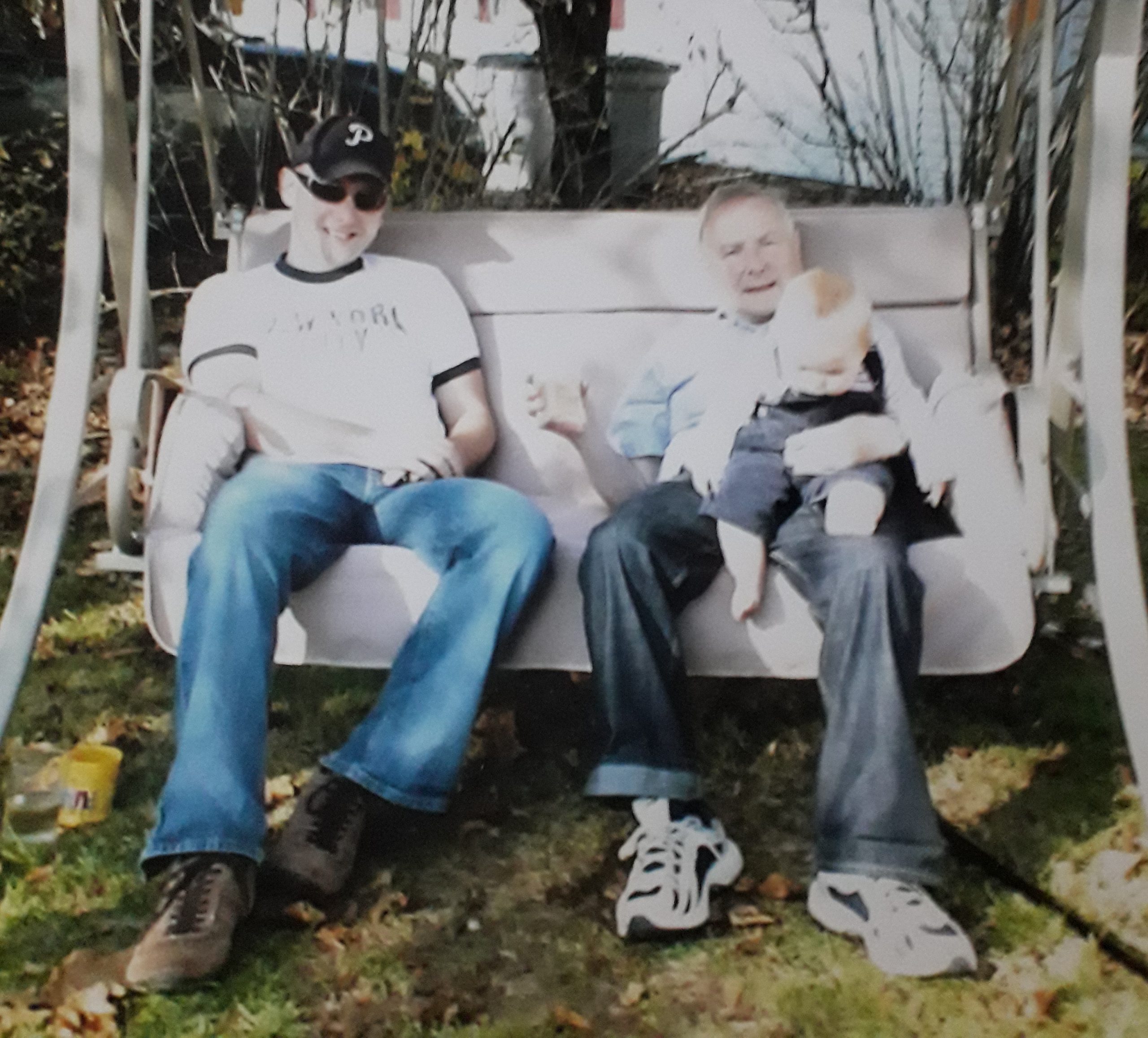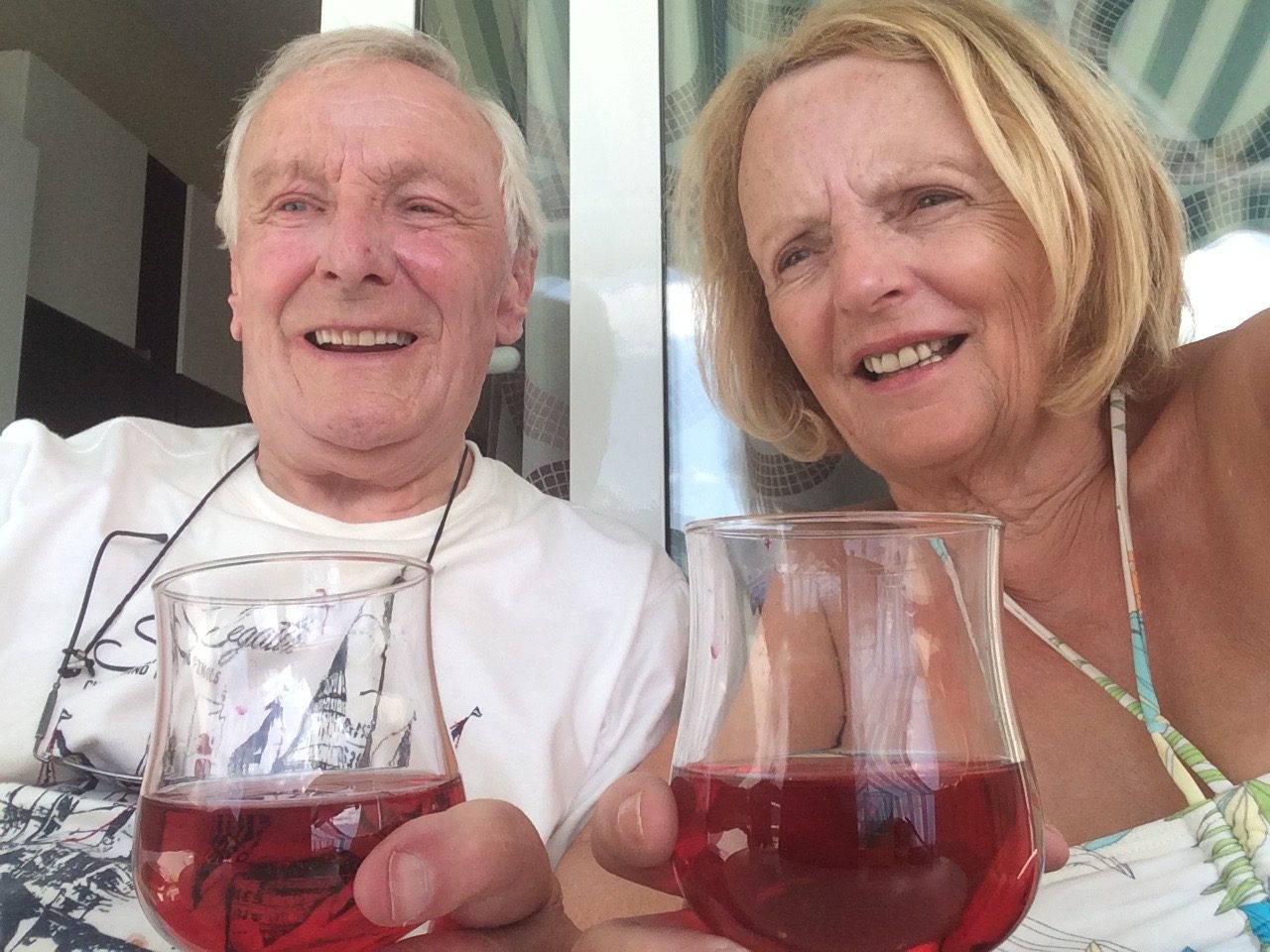Insert BlakelyPB40 Sammy and Betty
As we enter the final chapter of this brief memoir, we hear from Sammy in his own words about the many amazing travel adventures he and Betty have embarked upon and enjoyed over their years together.
The first foreign sun holiday was to Majorca in June 1980. We had booked the cheapest holiday in the brochure. Because of agent over booking we got a free transfer to a newly opened up market apartment. The first sight of the clear blue sky with permanent sun was, to us, amazing. It set our sights on following the sun and seeing other parts of the world.
Places we’ve been to see:
ITALY: We cruised the Mediterranean Sea to Pisa, Genoa, Rome, Florence, and Naples where we visited Pompeii. It was an eerie experience seeing images of all those people lost by the volcanic eruption of Mount Vesuvius in 75AD. We then went to Messina in Sicily where we were at the active volcano in Mt.Etna. We also cruised past Stromboli at night watching a continuous minor eruption about every twenty minutes. Spectacular to view in the dark.
For us, the two-week stay in Rome was a continuous treat. The architecture and associated history were awe inspiring: the Colosseum with the history of the different Emperors, the gladiators, the lions and the cruelty of the times; the Vatican, with its paintings of our Christian heritage from early Christendom by different Masters, like Michelangelo and Leonardo De Vinci; the interior of the Sistine Chapel with its paintings all telling of religious beliefs over centuries. The Sistine Chapel is one of the most accredited paintings with worldwide acclaim. I do not think that there is anywhere in Rome that doesn’t capture your interest. Insert Blakely4.11 Betty by the Trevi fountain in Rome Insert BlakelyPB54 Sammy and Betty, St. Peter’s Square and Vatican, Rome Insert BlakelyPB55 Inside the Basilica, Rome Insert BlakelyPB59 Betty inside the Basilica Insert BlakelyPB60 from the top of the dome of the Basilica Insert BlakelyPB56 Betty at the Colosseum, Rome Insert BlakelyPB61 Betty at the Colosseum Insert BlakelyPB57 Sammy and Betty taking a break from walking in Rome Insert BlakelyPB58 Betty at the DaVinci Museum, Rome
USA: The first introduction to the USA was in 2003. We went to visit Paul in Pompton Plains New Jersey, a terrific experience. We went up the Empire State Building, out to the Statue of Liberty, on a helicopter ride over Manhattan and out to see the aircraft carrier, the USS Intrepid, now a museum of aeronautics and space exploration. We also saw Times Square and had a meal in Planet Hollywood. We became so adept at getting around that we were able to take a bus from Pompton Plains into Manhattan and get local buses within Manhattan. Paul had several business fund-raising gatherings and we were invited to two of them. I think it was 2004. One of them had the film star Hugh O’Brien there. One night about $800,000 was raised. We knew we would be in Manhattan all day so, in order to attend, we bought a small carrier bag; as the time approached we went into Macy’s on Fifth Avenue, went downstairs to the toilet area and changed into our evening wear and went to the event, which seemed very clandestine. Insert Blakely4.1 Paul and Sammy in New Jersey
A few years later we again returned to the USA and stayed the first week with Paul and family and then we flew to LAX to begin a nine-day tour of the West Coast. All the places we saw in movies were on the tour schedule. In LA we went to the Hollywood Walk of Fame to see the floor stars and messages from all the famous film stars outside the Chinese Theatre, and the famous Hollywood sign. We also took a tour of Rodeo Drive in Beverly Hills where famous celebrities shop. The tour then took us on to San Francisco. We did a photo shoot at the Golden Gate Bridge and then took a boat ride out to visit the infamous Alcatraz prison. It must have been tough to spend time as an inmate, or even a warden on that island. Insert BlakelyPB46 Alcatraz keepsake
We then traveled to Monument Valley we saw what a beautiful a country America was and it looked just like what we thought the old West would look like. The scenery was used in a famous John Wayne film, The Searchers. (Our grandson Ethan, is named after John Wayne’s character in that movie, Ethan Edwards.) Our visit to Monument Valley convinced us that even though there is great poverty among them, the Navajo people are just lovely. Betty got a ride on a native American’s horse. We then moved on through Mojave desert and on to Las Vegas, which Betty says, “Appears to be consumerism gone mad. It’s a town for visiting, not for staying.” Seeing Vegas for the first time, it looks just as you imagined it: a city of seemingly nothing but fun, with opulent buildings, hotels, and obvious ways to entice people to spend money for the attractions. It is a great place to see and enjoy the many attractions. Insert BlakelyPB24 Betty with John Wayne, Route 66 Insert BlakelyPB16 Betty in Monument Valley on West Coast Tour Insert BlakelyPB49 Bryce Canyon Insert BlakelyPB50 Sammy, Calico, and Betty at a silver mining ghost town Insert BlakelyPB51 Grand Canyon
NYC Marathon – In November 2006 Betty participated in walking all around the boroughs in the New York City marathon, a memorable feat, with several other local people to raise £5000 for Mencap Northern Ireland. She is very proud of her marathon medal and certificate, prominently displayed in our home, but she also remembers that the end of the race was especially momentous. Insert Blakely1.11 Betty’s NYC Marathon Medal
While Betty walked the marathon course, Paul escorted me around New York and we could monitor her progress because of the microchip she had in her shoe. We could take a taxi to different points where we encouraged her as she passed. On the Washington Bridge, a policewoman in a car told Betty she couldn’t offer her a lift, but encouraged her, “Keep going! Keep going!” At one point, Paul said there was a problem because he wasn’t getting the signal from the race tracking device she wore; though I had a walking stick, I was by then pretty sore and tired and having trouble getting around. We waited a while, but Paul suddenly decided we just needed to go! “Dad, there’s something wrong. Come on!” So we headed off with my stick down the course in the opposite direction of the runners looking for Betty, though I didn’t know where we were going. Almost everyone had finished the race by then, so we didn’t disrupt anyone, we were just trying to find Betty. Insert Blakely1.12 Betty in the NYC Marathon
As Betty and the two other younger Irish ladies she was with were walking the last five miles, they saw that there were thousands of water bottles discarded on the road. The cleanup crews squashed the bottles and in the process, soaked Betty, who very quickly began shivering as it was now nighttime in November and the temperature had dropped significantly. There was debris everywhere. Betty found a sheet of silver foil and put it around herself as they struggled and struggled and struggled on to the end of the 26.2 mile course. As she crossed the finish line, Betty collapsed in a heap. She was exhausted, dehydrated, shivering, throwing up, and had to be treated by the race medics. When she was in the treatment tent, Paul and I went somewhere, but I cannot remember where or why, and when we got back to the finish line she was gone, taken by ambulance to the hospital. Someone told us she was taken to Mount Sinai hospital on West 59th Street, so we jumped in a cab and went to find her. The doctor explained to us that Betty was not ill, just dehydrated; half an hour on a drip of fluids made all the difference and she was feeling much better. Insert BlakelyPB21 Betty at the NYC Marathon finish line
Though it was a great adventure, Betty learned several things about Americans during that trip. One was that Americans expect to be tipped, as her waiter one morning at breakfast boldly informed her. Another was that Americans have no idea how to properly make tea! Betty likes her tea scalding hot. At the hospital, a nurse handed her a cup of tea and it was tepid, but Betty graciously held her tongue, which is rare. “Americans need to know: Tea is a dried herb,” Betty instructs. “You have to use boiling water!”
After the New York City Marathon, Paul sent us to Niagara to see the Falls. Getting on the plane to Buffalo, New York, we spoke to a young mother with her infant child. Strangely it turned out to be the wife and baby daughter of Paul’s work colleague, although we didn’t know it at the time. What a small world! When we landed in Buffalo we drove to our Niagara Hilton hotel. The Falls were a site to behold and during our stay we took a tour behind the Falls, another great experience.
FLORIDA: We also went to Florida and spent two days visiting Sea World and watching the dolphins and killer whales. We heard a young woman, roughly 20 years old, talk about how she always dreamed about getting a job working in Sea World with the dolphins and killer whales. She had been working there for several years. Three months after we had returned home to Ireland, the local news station carried a story about the same girl. Tragically, while standing beside the dolphins and whale area, one of the killer whales leapt into the air from the water and grabbed her by her hair, pulling her into and under the water. Unfortunately the girl drowned before anyone could help. She did the job she coveted most in the world, but with a tragic end. We also visited the Kennedy Space Center. We were able to go inside the Discovery space shuttle and were also able to go to a simulated launch where the entire floor vibrated.
In 2009 we went for a week to Washington, DC, with Barry. The icing on the cake was that Paul and family drove down from New Jersey to spend the time with us. It was a terrific week with both of the two families together visiting the sites, including the Capitol Building, the Washington Monument, Arlington Cemetery, the graves of President Kennedy and Robert Kennedy, the Lincoln Memorial, the Ford Theatre where Lincoln as assassinated, and the White House. A holiday to be cherished. Insert BlakelyPB25 JFK grave, Arlington Cemetary
We also spent time on a cruise from Los Angeles to Hawaii, a beautiful place. We went through three different time zones on the way. It was lovely walking on Waikiki beach in Oahu. We visited the Pearl Harbor memorial and learned about the tragic fatal attacks of that day. We also went out to see the wreck of the USS Arizona which had been sunk with the loss of about 1,200 people. Insert BlakelyPB17 Sammy & Betty on a cruise to Hawaii
I have also been to the USA in New Orleans and Wilmington, Delaware, for company meetings for the DuPont Company in 1996.
MOROCCO: We visited a SOUK market, a carpet street market and a Moroccan leather clothes shop, on a tour from a cruise. A lovely place. I took ill in the leather shop with a severe chest pain. We had to abandon the tour and get a taxi back. Our tour guide told us what the fare to the ship should be; but as we headed for the ship, the taxi driver kept trying to negotiate more money! We went straight to medical. The ship’s doctor performed a cardiograph and several other tests, but could find no obvious cause. He asked if there were any other medical problems, and I casually said, “No, only some reflux.” He jumped up and said “That’s it. Have you tablets?” He more or less said I obviously had not been taking them regularly. He sent Betty to the cabin to get the tablets. She was exhausted running to the cabin. True to form the doctor was right that I should have been taking the medicine regularly as prescribed, and it taught me a lesson. After the commotion died down and everything was back to normal, Betty told everyone the chest pains happened because I was afraid of her spending too much money in the leather shop. She knows how to spend, so was probably right. Insert BlakelyPB47 Betty at carpet market, Morocco Insert BlakelyPB48 Betty and Sammy at carpet market
EGYPT: Our first trip to Egypt was on a Red Sea cruise. We were at Petra in Jordan. The ancient temples, created out of the mountainside, were amazing. Although only ruins now, the architecture was amazing. The narrow gorge route to the temple was made famous to us in an Indiana Jones film with Harrison Ford. From here we sailed to Egypt. The country has so many attractions from the Pyramids to thousands of statues of past notable figures including Tutankhamun, the boy Pharaoh, whose tomb we visited. We went back a second time to Egypt, this time on a Nile cruise. An idyllic experience. The river is beautiful and may still be the longest in the world. People in Egypt’s tourist areas seem to be poor, but cordial. Insert BlakelyPB38 Sammy and Betty on Egyptian Nile cruise Insert BlakelyPB52 Betty on Egypt cruise Insert BlakelyPB53 Betty in Egypt
SPAIN: We spent a lot of holidays in Spain, on the mainland in Majorca and in Menorca. We always seemed to get really good weather. There are four Spanish islands, Tenerife, Grand Canaria, Lanzarote and Fuertaventura, off the northwest coast of Africa. We’ve been to them all, but our favourite holiday spot now is Tenerife with its warm temperatures in the dead of an Irish winter. We were last there in February 2020. We flew back home on the 21st of February. One week later the Covid-19 virus had infected a hotel in Tenerife and the island was put on lockdown. We were very lucky to get home before that happened.
THE CARIBBEAN: We took several cruises around the Caribbean Sea. We’ve been to Jamaica, Haiti, St. Lucia, and Cozumel in Mexico. All of these islands are so beautiful. They unfortunately have weather worries with hurricanes and storms. One of our tour guides pointed to a section of forest and explained that there were people buried there under landslides that would never be removed. There is unfortunately a lot of poverty here. Insert BlakelyPB34 great holiday, St. Georges Insert BlakelyPB35 Jamaica 2009
SWEDEN: Stephen lives in Sweden with Tina, Noah, Lily and Amelia. Stockholm is a beautiful city; it seems so inviting with its “place for everything and everything in its place” culture, and public transport which runs pretty much always on time. Everything seems so organised. Insert Blakely4.2 Stephen and Sammy in Sweden
IRELAND: The “Pièce de Résistance,” our home. Naturally we have traveled the length and breadth of the Island. The biggest negative can only be at times the weather. It’s never too hot and never too cold. The compensation for that lies in its beautiful green land and its heritage, going back thousands of years. The scenery is so beautiful and because it is a small island the most spectacular views are from around its easily reachable coastline. Ireland is known as the Land of Saints and Scholars, because of the number of famous poets and scholars born here: Oscar Wilde, Seamus Heaney, George Bernard Shaw, James Joyce, Brian Friel (an old teacher at my school and a noted playwright), Michael Collins, Maureen O’Hara, Bono, Enya, Liam Neeson, and Mary Robinson, the first female president of Ireland who is credited with positively contributing to the transformation of Ireland into a modern country, to name but a few. You gathered from our introduction, Ireland was a place where times past were of hardship and some poverty, but always a place where people made the best from what they had. Times for our parents and grandparents were tough, but not so now. Instead of looking forward to leaving school to earn some money, Irish people look forward to further secondary and university education and subsequently better employment. There are Irish business leaders, philanthropists, and volunteers working for worthy causes all over the world today.
Betty and I have come a long way from the hardships of the past and are proud of our children and grandchildren. We encourage them to work hard, have lots of fun, and travel widely. It’s a beautiful, big world out there. Insert BlakelyPB39 Lori, Sammy and Paul at Guildhall Square, Derry





